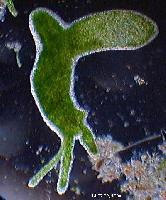
Description de l'animal
The Green Hydra (Hydra viridissima) is a fascinating, small freshwater organism belonging to the phylum Cnidaria, which also includes more familiar creatures like jellyfish, corals, and sea anemones. This intriguing species is particularly known for its bright green coloration, a feature that sets it apart from its relatives and plays a significant role in its survival strategy. The green color is not just for show; it is the result of a symbiotic relationship with green algae known as zoochlorellae, which live within its cells.Typically measuring just a few millimeters in length, the Green Hydra has a simple yet effective tubular body structure. The base of its body, or foot, attaches to submerged rocks, plants, or other surfaces in its freshwater habitat, which can range from clear ponds to slow-moving streams. Extending from its tubular body is a mouth surrounded by a ring of tentacles. These tentacles are not only remarkable for their role in capturing prey but also for their content of specialized cells called cnidocytes. Cnidocytes contain nematocysts, which are explosive cells that can discharge toxins to stun or kill small aquatic invertebrates, which the hydra then consumes.
The relationship between the Green Hydra and the green algae living within its cells is a classic example of mutualism. The algae conduct photosynthesis, producing oxygen and organic compounds that nourish the hydra. In return, the hydra provides the algae with a protected environment and access to sunlight, which is necessary for photosynthesis. This symbiotic relationship allows the Green Hydra to survive in environments with low nutrient levels where other predators might struggle.
One of the most remarkable aspects of the Green Hydra is its regenerative abilities. This organism can recover from injuries and even regenerate entire parts of its body. This capability is due to the presence of stem-like cells that can differentiate into various cell types. Scientists study these processes with the hope of gaining insights into regenerative medicine and aging.
The reproductive strategies of Hydra viridissima are equally fascinating. It can reproduce both sexually and asexually. Asexual reproduction occurs through a process called budding, where a new, genetically identical hydra forms from the side of an existing one and eventually detaches. Sexual reproduction, on the other hand, happens under specific conditions, usually related to changes in the environment. It involves the formation of eggs and sperm for the creation of genetically unique offspring, contributing to the genetic diversity of the population.
Despite its small size, the Green Hydra plays a significant role in its ecosystem. It is a predator of small invertebrates, helping to control their populations, and serves as a food source for larger organisms. Additionally, its existence helps scientists understand the complexities of symbiotic relationships, regeneration, and the evolutionary biology of cnidarians.
In conclusion, the Green Hydra (Hydra viridissima) is more than just a tiny green speck in freshwater habitats. It is a complex organism with unique biological features, from its symbiotic relationship with algae and remarkable regenerative abilities to its simple yet effective hunting techniques. The study of this small but mighty creature continues to provide valuable insights into biology, ecology, and the potential applications of its unique characteristics in science and medicine.
Animaux similaires
Nouvelles photos d'animaux
Top 10 des animaux
- Dolphin gull (Leucophaeus scoresbii)
- Diana monkey (Cercopithecus diana)
- Moustached guenon (Cercopithecus cephus)
- Galápagos tortoise (Geochelone nigra complex)
- Stone loach (Barbatula barbatula)
- Japanese macaque (Macaca fuscata)
- Russian tortoise (Testudo horsfieldii)
- Greek tortoise (Testudo graeca)
- Common flying dragon (Draco volans)
- Vendace (Coregonus albula)
